In the ever-evolving world of technology, students need tools that not only support their academic pursuits but also nurture their curiosity and creativity. Linux, with its open-source ethos and versatility, has emerged as a go-to solution for learners of all ages. But with so many distributions available, how do you pick the one tailored for students? Fear not—we’ve done the homework for you.
In this guide, we’ll explore five standout Linux distributions built specifically for students in 2025. These distros are packed with educational tools, user-friendly interfaces, and features that make studying and exploring knowledge a breeze. Let’s dive in and find the perfect Linux companion for your educational journey!
Top 5 Linux Distributions for Students in 2025
1. Edubuntu
Edubuntu, an official Ubuntu flavor tailored for educational environments, has long been a valuable resource for students and educators. After a hiatus, it was relaunched in April 2023 alongside the Ubuntu 23.04 release, bringing updated features and tools designed to enhance the learning experience.
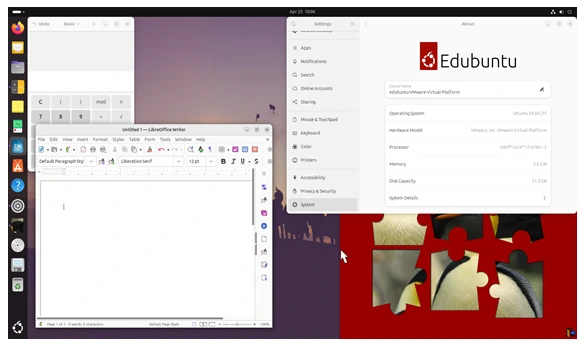
What Is Edubuntu?
Edubuntu integrates the robust Ubuntu operating system with a suite of educational applications, making it an ideal choice for classrooms, homes, and educational institutions. Its user-friendly interface and comprehensive software selection cater to students of various age groups, from primary school to university levels.
Key Features of Edubuntu
- Educational Software: Edubuntu comes pre-installed with a wide range of educational applications, including GCompris (for children aged 2 to 10), Tux Paint (a drawing program for young children), and the KDE Education Suite, which offers programs for mathematics, science, language studies, and more.
- User Management: The system provides tools that allow educators and parents to manage user accounts effectively, ensuring a safe and personalized learning environment for each student.
- Regular Updates: As an official Ubuntu flavor, Edubuntu benefits from regular updates and a strong support community, ensuring that the system remains secure and up-to-date with the latest educational tools.
Why Choose Edubuntu for Students?
- Cost-Effective: Being open-source, Edubuntu is free to download and use, making it an affordable option for educational institutions and families.
- Customizable: Educators can tailor the system to meet specific educational needs, adding or removing software as required.
- Community Support: A vibrant community of users and developers is available to provide support, share resources, and collaborate on improving the system.
Getting Started with Edubuntu
To install Edubuntu, you can download the latest version from the official website. The installation process is straightforward, with options to install it alongside your existing operating system or as the primary OS. Comprehensive installation guides and community forums are available to assist with any questions during the setup process.
Edubuntu offers a versatile and user-friendly platform for students and educators, combining the reliability of Ubuntu with a rich selection of educational software. Its recent relaunch ensures that it remains a relevant and valuable tool in modern educational settings, supporting diverse learning needs and environments.
For more information and to download Edubuntu, visit the official website: Edubuntu.
2. Skolelinux (Debian Edu)
Skolelinux, also known as Debian Edu, is a specialized version of the Debian operating system tailored for educational institutions. Its primary goal is to provide schools with a free, stable, and versatile IT infrastructure that supports both teaching and administrative tasks.
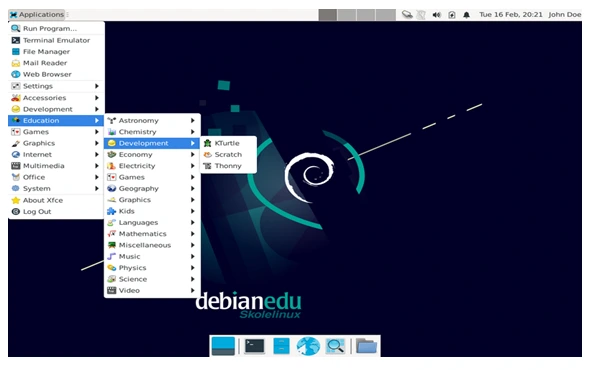
Key Features of Skolelinux:
- Comprehensive Educational Suite: Skolelinux comes pre-installed with a wide range of educational software suitable for various age groups and subjects. This includes tools for learning mathematics, science, languages, and more, ensuring that students have access to diverse learning resources.
- Centralized Network Management: Designed to support a networked environment, Skolelinux allows for centralized user and system management. This feature simplifies administrative tasks, making it easier for schools to maintain their IT infrastructure.
- Support for Thin Clients: Skolelinux efficiently supports thin client setups, enabling schools to utilize older or less powerful hardware as terminals. This approach can significantly reduce costs and extend the lifespan of existing equipment.
- Multilingual Support: Recognizing the global nature of education, Skolelinux offers extensive language support, allowing students to learn in their native languages.
Recent Developments:
As of January 2025, Skolelinux continues to be actively maintained by a dedicated community of developers and educators. The latest updates have focused on enhancing system stability, updating educational software packages, and improving user experience based on feedback from schools worldwide.
Benefits for Educational Institutions:
- Cost-Effective: Being an open-source solution, Skolelinux eliminates licensing fees, allowing schools to allocate resources to other essential areas.
- Customizable: Schools can tailor the system to meet their specific needs, ensuring that the IT environment aligns with their educational goals.
- Community Support: A vibrant community surrounds Skolelinux, offering support, resources, and shared experiences to help institutions make the most of the platform.
Skolelinux (Debian Edu) stands as a robust and adaptable solution for educational institutions seeking to integrate technology into their teaching and administrative processes. Its commitment to providing a free and comprehensive educational platform makes it a valuable asset for schools worldwide.
For more information or to get involved with the Skolelinux community, visit the official Debian Edu website.
3. AcademiX GNU/Linux
Exploring AcademiX GNU/Linux: The Perfect Linux Distribution for Students
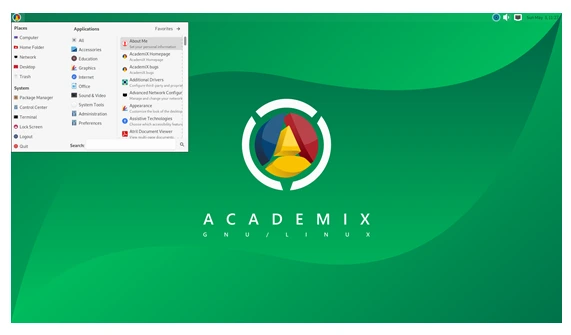
When it comes to fostering a learning environment in the digital age, tools that blend accessibility, functionality, and cost-effectiveness are paramount. AcademiX GNU/Linux, a Debian-based Linux distribution, emerges as a solution tailored specifically for students, educators, and educational institutions. Packed with features and educational software, it empowers learners of all ages to excel in various academic fields.
What Is AcademiX GNU/Linux?
AcademiX GNU/Linux is a specialized Linux distribution aimed at educational purposes. Built on the stable base of Debian, it offers a comprehensive suite of free and open-source tools. Whether you’re a student tackling STEM subjects, an educator looking to streamline teaching materials, or an institution seeking cost-effective software solutions, AcademiX has something for you.
Key Features of AcademiX GNU/Linux
1. Extensive Educational Software
AcademiX GNU/Linux comes pre-loaded with a variety of applications catering to different subjects:
- Mathematics: GeoGebra, TuxMath, and Mathomatic.
- Science: Kalzium for chemistry, Stellarium for astronomy, and Freemat for numerical analysis.
- Programming: Scratch for beginners, Python, and more advanced tools for coding enthusiasts.
- Graphics and Design: LibreCAD for engineering and design students.
- Music and Multimedia: Audacity for audio editing, MuseScore for music notation, and OpenShot for video editing.
These tools cover a wide range of academic disciplines, ensuring students and educators have access to what they need without additional installations or purchases.
2. Lightweight Yet Powerful Desktop Environment
The distribution uses the MATE desktop environment, known for its simplicity and resource efficiency. This ensures smooth performance even on older computers, making it a great choice for schools and colleges operating on tight budgets.
3. Customizable for Curriculum Needs
One standout feature of AcademiX GNU/Linux is its modular installation system. Educators can curate lists of applications relevant to their curriculum and share these lists with students. This allows learners to install all necessary software with a single click, saving time and ensuring uniformity.
4. Free and Open Source
All software included in AcademiX GNU/Linux is licensed under GNU GPL or BSD licenses. This not only eliminates licensing costs but also promotes a culture of sharing and collaboration. Institutions and individuals can modify and redistribute the software as needed.
5. Hardware Compatibility
AcademiX is designed to work seamlessly on a variety of hardware configurations. From older desktops to modern laptops, its lightweight nature ensures that even underpowered systems can function effectively.
Why Choose AcademiX GNU/Linux?
Cost-Effective for Institutions
For educational institutions, budgets often present a significant challenge. AcademiX GNU/Linux removes the need for expensive proprietary software licenses. Combined with its compatibility with older hardware, it drastically reduces IT infrastructure costs.
Support for Collaborative Learning
The inclusion of programming tools, multimedia editors, and scientific simulators encourages project-based learning and collaboration among students.
Secure and Stable
Built on Debian, AcademiX benefits from one of the most stable and secure bases in the Linux world. Regular updates ensure security patches and bug fixes are always available.
System Requirements AcademiX GNU/Linux
AcademiX GNU/Linux is remarkably lightweight and can run on older systems. Below are the approximate minimum requirements:
- Processor: 1 GHz or higher.
- RAM: 1 GB (2 GB recommended for smoother multitasking).
- Storage: 8 GB of free disk space.
- Graphics: VGA or higher resolution screen.
Getting Started with AcademiX GNU/Linux
Step 1: Download the ISO
Visit the official AcademiX GNU/Linux website and download the latest ISO image.
Step 2: Create a Bootable USB/DVD
Use tools like Rufus (for Windows) or dd command (for Linux) to create a bootable drive.
Step 3: Install or Run as Live System
AcademiX can be tested as a live system without installation. If it meets your needs, proceed to install it on your system using the step-by-step installer.
Step 4: Explore the Educational Tools
Once installed, dive into the diverse range of pre-installed applications. Educators can also customize and install additional software as needed.
AcademiX GNU/Linux stands out as a holistic solution for the educational field. Its ability to provide a broad range of academic tools, coupled with its cost-effectiveness and lightweight design, makes it a perfect choice for students, educators, and institutions worldwide.
By choosing AcademiX, you’re not just adopting a Linux distribution—you’re joining a global community committed to open knowledge and accessible education. So why wait? Give it a try and experience the power of learning on an open platform.
4. Sugar on a Stick (SoaS)
In today’s digital age, equipping students with the right tools is essential for fostering an engaging and effective learning environment. One such tool is Sugar on a Stick (SoaS), a portable operating system tailored specifically for educational purposes.
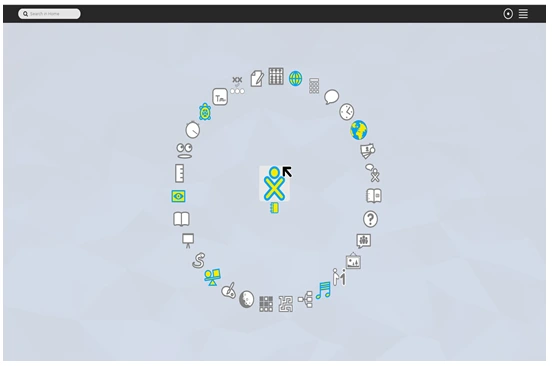
What Is Sugar on a Stick?
Sugar on a Stick is a Fedora-based operating system that features the award-winning Sugar Learning Platform. Designed to run from a USB flash drive, it transforms any compatible computer into an interactive learning hub without altering the host system’s existing setup.
Key Features of SoaS:
- Child-Friendly Interface: Sugar’s intuitive design emphasizes simplicity and engagement, making it accessible for young learners.
- Pre-Installed Educational Activities: SoaS comes equipped with a variety of applications that promote exploration, creativity, and collaboration.
- Portability: By operating directly from a USB stick, students can carry their personalized learning environment anywhere, ensuring consistency across different computers.
- Cross-Platform Compatibility: SoaS can run on various hardware, including Windows and macOS systems, broadening its accessibility.
Recent Updates:
The latest release of Sugar on a Stick includes:
- Sugar 0.118: This version offers enhanced performance and new features to enrich the user experience.
- Based on Fedora 35: Leveraging the stability and advancements of Fedora 35 ensures a robust and secure platform for learners.
Getting Started with SoaS:
- Download the ISO: Obtain the latest SoaS image from the official Sugar Labs website.
- Create a Bootable USB: Use tools like Fedora Live USB Creator to load the ISO onto a USB drive.
- Boot from USB: Insert the USB into your computer, adjust the BIOS settings to boot from USB, and start exploring Sugar’s learning environment.
Detailed installation instructions are available for various operating systems, ensuring a smooth setup process.
Why Choose Sugar on a Stick?
SoaS offers a unique blend of portability, user-friendly design, and a focus on education. It’s an excellent resource for students, educators, and parents aiming to integrate technology seamlessly into the learning journey.
By providing a consistent and engaging platform, Sugar on a Stick empowers students to take control of their learning, fostering both independence and collaboration.
For more information and to download Sugar on a Stick, visit the official Sugar Labs page.
5. DoudouLinux
In today’s digital age, introducing children to computers in a safe, educational, and engaging manner is paramount. DoudouLinux, a Linux distribution tailored specifically for children aged 2 to 12, offers a solution that combines simplicity with a rich array of applications designed to foster creativity and learning.
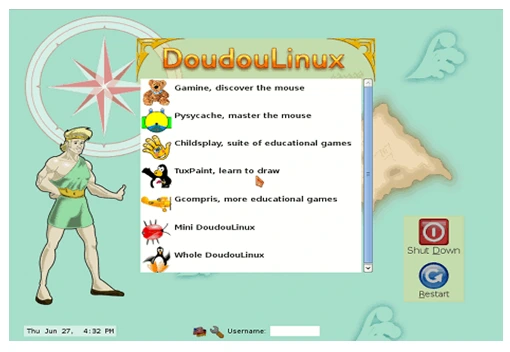
What is DoudouLinux?
DoudouLinux is an operating system crafted to make computer use as straightforward and enjoyable as possible for children. Its interface is designed to be as intuitive as a gaming console, allowing young users to navigate and explore without constant supervision. The system comes preloaded with numerous applications catering to various age groups and interests, including educational games, creative tools, and learning activities.
Key Features:
User-Friendly Interface: The environment is simplified to ensure ease of use, enabling children to focus on learning and creativity without being overwhelmed by complex menus or settings.
- Educational Content: DoudouLinux includes a variety of applications that promote learning in areas such as mathematics, reading, and problem-solving, making education both fun and interactive.
- Creative Tools: Children can explore their artistic side with drawing programs, music creation tools, and other applications that encourage creativity.
- Parental Controls: To ensure a safe browsing experience, DoudouLinux is equipped with built-in content filtering, preventing access to inappropriate websites.
- No Installation Required: DoudouLinux can run directly from a CD or USB stick, meaning it doesn’t interfere with existing systems or data on the computer. This portability allows it to be used on multiple devices without installation.
Why Choose DoudouLinux?
DoudouLinux is more than just an operating system; it’s a platform that encourages children to discover the vast potential of computers beyond passive consumption. By providing tools that promote active engagement, creativity, and learning, it helps children develop essential skills in a controlled and safe environment.
Moreover, DoudouLinux is built on free software principles, emphasizing the importance of knowledge sharing and collaboration. This approach not only makes it accessible to everyone but also instills values of openness and cooperation in young users.
Current Status:
As of January 2025, it’s important to note that the development of DoudouLinux has been inactive for several years, with the latest stable release being version 2.1, “Hyperborea,” released in December 2013. While the software remains functional and can be a valuable tool for children’s education, users should be aware that it may not receive updates or support for newer hardware and technologies.
DoudouLinux offers a child-friendly computing environment that balances fun and education, making it an excellent choice for parents and educators seeking to introduce young learners to the digital world. Its thoughtful design and comprehensive features ensure that children can explore and create safely, laying a strong foundation for future technological proficiency.
For more information or to download DoudouLinux, visit their official website:
Conclusion
These Linux distributions cater specifically to students, ensuring their academic and personal growth through carefully curated tools and environments. Whether you’re a college student managing assignments or a teacher running a classroom, there’s a Linux distro tailored for your needs.
In 2025, transitioning to a student-focused Linux distribution can empower learning, foster creativity, and simplify academic tasks. Try one of these distributions to experience the transformative potential of open-source education!
Disclaimer
The information provided in this blog is based on research and is intended for informational purposes only. The recommendations are subjective and tailored for general student needs. Individual preferences and requirements may vary. Always test a Linux distribution to ensure it meets your specific academic and personal needs before fully transitioning to it.
Also Read
Top 5 Linux Mobile Operating Systems You Should Try in 2025


